#How To Annotate Books for Beginners
Explore tagged Tumblr posts
Video
youtube
How To Annotate Books for Beginners - Learn to Annotate with Me!
0 notes
Video
youtube
How to Annotate Texts and Books for University (12 Ways)
#youtube#how to annotate#annotations#annotate for beginners#how to annotate for school#university#university tips#how to annotate for university#annotate books#annotate textbooks#literature#literature classes#how to annotate literature#studying tips#university student
6 notes
·
View notes
Text

How to Study Resources
Many people in the modern day pagan/polytheist communities are young. As such, a majority of them are neurodivergent, like I am. For me, that means a majority of the language used in resources is difficult to understand. This was originally going to be a post about that, but the more I wrote, the more I realised that many people, neurodivergent or not, just... don't know how to study resources. So, if you are someone that also struggles, I now present to you... my full guide on how to study resources.
Little disclaimer: I myself am a hellenic polytheist, but this guide is for anyone that struggles with understanding information from resources, whether you are a hellenic polytheist, norse polytheist, kemetic polytheist, etc. Though do understand that I am writing from the perspective of a hellenic polytheist, so I am bound to make mistakes when it comes to religions I am less educated on. You are always welcome to adjust anything I say here to fit your own religion accordingly.
Let's get started.

Firstly, you have to find resources. Many people happen to get stuck here, unfortunately.
How do I know what to research to begin with? When starting out, the general consensus among the polytheist/pagan communities is to research the related historical practice. How the deities were worshipped, what contexts they were worshipped in, the history of the deities, etc etc... all of these are very important factors to consider as a beginner. Only by knowing the history can you then delve deeper into specific terms and specific paths that may be right for you!
How do I find resources? Unfortunately, a lot of resources are behind paywalls or just plain hard to find. Here is a list of websites that I personally use and recommend:
scholar.google.com
academia.edu
pdfdrive.com
library.memoryoftheworld.org
libcom.org
libretexts.org
standardebooks.org
By the way, just a reminder that if you find a resource but there is a pesky paywall in your way, you can probably find it on archive.org for free!
How do I choose a resource though? If you are part of hellenic polytheism, then theoi.com is a great resource, but I always like to add primary sources into my research + not everyone reading this will be part of helpol. Try to find primary sources, first and foremost. Then read historical accounts. Then read secondary sources. Also, make sure your author is reliable! (that link is only for hellenic polytheism though, apologies. If you are not part of hellenic polytheism, then looking into who the author is/was as a person and what sort of contributions they made and beliefs they held never failed me personally!)

Found your resource? Made sure the author is reliable? Wonderful! Now what?
This is usually where the procrastination hits for me. Either that, or I get hyperfocused for a while but never complete it and then lose interest.
To avoid that, break things down and establish a routine. You do not have to finish a book in a day, or understand everything you read straight away. Setting those kinds of expectations for yourself will only make things so much more difficult.
Instead, make a routine for yourself. Outlined below is my routine:
Getting into the mindset. I always like to get myself into the mindset of studying by praying, whether this is studying for school or studying a resource. Since my entire life is devoted to lord Apollon, I pray to Him for it. However, if I am researching a specific god, I will typically pray to them instead. However, sometimes I do not have the spoons to write out a prayer, so I typically just adjust my surroundings instead. Turning my LED lights to a warmer colour and putting on some lofi music usually helps me! The studyblr community has great tips for this part! I also recommend I Miss My Cafe.
Reading. First, I try to read without annotating or taking notes. This is the time to take in the information, to try and grasp what I am reading. This is usually the most difficult part for me, because a lot of academic sources tend to use advanced language and sentence structures that are difficult for me to understand. Unfortunately, the only tip I have for this part is to read as slowly as you need. Do not be ashamed for taking your time. Typically, I only like to read one paragraph before I move onto the next step.
Annotation. This is where I re-read the paragraph I just read. Typically, I like to re-word the paragraph in a simpler way for me to understand. Sometimes I notice little patterns that may connect back to something I've read prior, whether in another book or earlier in the same book. When that happens, that is something I add too! Remember, you do not have to annotate. If it makes it easier, then perfect! If it does not, discard it.
Consult study tools. This is where I cross-reference with other resources. This is how the entire process repeats again. Though, you do not just have to use books for this part! YouTube videos, podcasts, online resources, etc etc...these always help too!
Application. After vetting the information, consider how it would apply to your life, if at all.
Of course, that's just my routine. You are always welcome to use it, but I also greatly encourage you to create your own routine so that you can cater it to your learning style!
I also recommend setting a time limit for yourself. If you have not completed a chapter within the time limit, that is okay! The most important thing about researching is making sure you are not guilting yourself into biting off more than you can chew. Take your time, you have a lot of it.

Research is vital to religions like ours, and research should be something everyone can do! Just because you may need some accommodations does not make you any less intelligent. We all learn differently. That is okay.
I hope this post can serve as something helpful for those who struggle in this area, and as a reminder that you are not alone in your struggles. If you have any questions or would like further clarification on some points, feel free to reach out!
Xaire ♡
#guides ୨୧#beginners ୨୧#helpol#norsepol#kempol#resources#polytheism#hellenic polytheism#norse polytheism#norse paganism#kemetic polytheism#kemetic paganism#kemetism#hellenic worship#kemetic worship#norse heathen#helpol resources#helpol research#demonolatry#theistic satanism#luciferian#luciferianism
381 notes
·
View notes
Note
Van!! since the postseason is slowly approaching its own end i've been wanting to get more into hockey analysis as this is my first full season as a fan and i still have a lot to learn about the game itself. Idk where to start but i feel like out of my mutuals you know a good bit about that stuff so I was wondering if you have any resources you could point me to? books or youtubers etc
Mei rubberpuckies... <3 Can't say I've got every answer but here are some of the places I visit:
Probably the easiest way to start learning is to have the game in motion in front of you and have someone explain it, video content hits that perfectly!
This video covers player roles. Good way to start understanding how each role fits into a 5-person unit. Content meant for new hockey players or players who are young/transitioning into a new role, and no game footage but the colour coded diagrams and explanation was very useful to me!
This guy also makes content meant for hockey players and doesn't post much, but he covers broader tactical concepts (and uses woho clips, which is so cool!). His videos are very digestible!! Short, have diagrams and bullet point slides... just great introductions to stuff like d-zone coverage and forechecking concepts.
Steve Peters used to work with the Coyotes and now runs Inside the Coaches Room. You might've seen some short clips of his content floating around on twt, he breaks down clips from current/recently played games so they're very relevant!! He's doing playoffs content now. I like his hockey for beginners video a lot as a catch-all primer for NHL ice hockey (I have linked the playoffs edition, it's a very good watch)
Hockey Psychology does some scattered tactical breakdowns of games, most recently FLA @ TOR Game 7. Not a huge fan of their clickbait style video titles or thumbnails but hey, whatever gets them noticed!
Simon St-Laurent does video reviews on the big names amongst draft eligible players. He comes to his own conclusions about the players in isolation of the broader game so you kinda have to take that as you will... I think, like everyone who watches a sport for long enough, scouts and prospect writers have their very specific beliefs about how the game should be played and it shows in the way they evaluate players. I like St-Laurent because he has a coherent, consistent framework that he pulls from. Maybe we won't agree all the time, but at least I can kinda understand how he arrives at his opinions.
In the same vein, Elite Prospects run a channel and like to get various writers to make short scouting videos on players. With the multitude of voices your mileage may vary, but I've enjoyed their work!
Kyle MacLennan on twt/x posts short clips of recent games and tends to highlight one aspect that he noticed. I have this man on notifications I'll be honest!! Clips come with no voice over explanation but lots of annotations and freeze frames. His stuff is the most bite-sized, 1-2min clips of games with a short blurb - wish I could be as concise as him <3 his most recent thread highlights FLA's tight checking in Game 7.
Further reading is... idk I don't want to be that guy because I also just got here but it's frustrating how so much high quality content and hockey knowledge is locked behind paywalls. I believe in my heart all writers should be paid for their work. I also know there is an appetite for deeper hockey analysis out there that could grow the game if only they'd let it </3 MAN!!!
I spend real actual dollars on Jack Han's Hockey Tactics books, which he releases every year part way through the season after watching every NHL team play. There are pictures and explanations of how each team runs their system, and this year's edition has an end section with anecdotes from industry people which I loved digging through. You don't have to buy it but if you find that you're really interested in the analysis side of things it's an incredible resource!! He's also on twt/x where he comments on the game and occasionally does little video review, and runs a paid Substack with the occasional free article <- this one I can't afford but ouggghhh when I get more disposable income.......
Beyond general analysis, there are so many blogs and writers that do cover specific hockey teams I don't think I could name them all if I tried. If you go looking for that sorta thing there'll always be some nerd out there obsessively watching tape and writing about it (and sometimes it's Sheng Peng <3)
Love and light but this is getting really long and I don't want to overwhelm you. You aren't the first person to ask about resources and I've been meaning to do a roundup of publications/channels I like to dig through so thank you for dropping by and prompting me!!
39 notes
·
View notes
Text
« INTRO: AWAKEN TO (YOUR)SELF »
A BEGINNERS GUIDE TO ALL THINGS CONSCIOUSNESS

This blog used to be a journal in the process of self realization of it's creator but has yet turned out to be a collection of sources and information guiding you too on your way back to your true Being. It all started with the question: “Who are you really?” and the realization that reality is not what it seems. I'm at a point now where I do not follow any teachings or concepts anymore nor did I consent in strictly deviding law of assumption from non dualism in the past. Nowadays, I see myself as an advocate for Self-realization. That being said, I really want to distance myself from any "new age manifestation/law of assumption" (do this to get xyz) teachings practised on youtube or tiktok.
I did create my own content in the past but stopped because there is nothing new to say and my understanding has deepened. Posts and annotations written by me are easily recognisable by my typical colour code, which is obviously displayed here. I only answer questions for understanding or clarification, guidelines here.

HOW TO START
Advaita Vendata (Non Dualism): an Introduction
Core of non dual understanding
youtube
If everything is consciousness, I am everything and everything is me? I still feel like "me", I don't feel like god of my reality How to become aware(ness) How to control the thoughts How to be free from emotions and thoughts Stop concerning yourself with the wants and needs of Ego How to loose attachment to Ego What you really are How to be Consciousness/ Awareness
In the end, the only question remaining should be who you are without all the labels attached to "I am". You will come to discover you do not want freedom from this shape alone, but from all shapes. Be aware of your past being over. "External world shows otherwise? Just be like "for how long do you think it can keep this up when you have nothing to do with it?" @Ada
youtube

MY CONTENT/ EPIPHANIES
You can experience pain in your life but you don’t have to ‘suffer’ the pain.” - Anon I mus
#masterpost, #goddessawakening
» Mosaic » Be yourself first »"Manifesting" » Freedom » Being » Why everbody misinterprets Self concept » Is there a real difference? »Misidentification » Consciousness & Limitation » No others » Question Reality » Missing » Ego & Time

ADDITIONAL MATERIAL
... what to find on my blog through the tags
Advise/FAQs: Koda, Nova, iam-you, Cassie, Bry, Jag, Vesora, Lain, more What is Ego? How it feels to be Self / Awareness All on Self Realization and Detachment All on LOA trough a non dualistic view Books
If you still want to focus on "getting your desires" after been through all the info, search Neville Goddard (all his books and lectures). If you have a hard time understanding Neville, I advise some people who break down his teachings in a short and modern way of speaking: Edward Art (Reddit(Series), Audio), embodythestate, niclasupgradetolife, Josiah Brandt on YouTube
#this is a sideblog#consciousness#law of consciousness#non dualism#non-dualism#non duality#non-duality#awareness#neville goddard#edward art#law of assumption#loass#goddessawakening#Youtube
586 notes
·
View notes
Note
hi, i haven't read the iliad and the odyssey but want to - do u have a specific translation you recommend? the emily wilson one has been going around bc, y'know, first female translator of the iliad and odyssey into english, but i was wondering on if you had Thoughts
Hi anon! Sorry for the somewhat late response and I'm glad you trust me with recommendations! Full, disclosure, I am somewhat of a traditionalist when it comes to translations of the source text of the Iliad + Odyssey combo wombo, which means I tend to prefer closeness in literal verbiage over interpretation of the poetic form of these epics - for that reason, my personal preferred versions of the Odyssey and Iliad both are Robert Fitzgerald's. Because both of these translations (and his Aeneid!) were done some 50+ years ago (63 for his original Odyssey tl, 50 flat for his Iliad and 40 for his Aeneid) the English itself can be a bit difficult to read and the syntax can get confusing in a lot of places, so despite my personal preferences, I wouldn't recommend it for someone who is looking to experience the Iliad + Odyssey for the very first time.
For an absolute beginner, someone who has tried to read one or both of these epics but couldn't get into it or someone who has a lot of difficulty with concentrating on poetry or long, winding bits of prose, I fully and wholeheartedly recommend Wilson's translation! See, the genius of Emily Wilson's Iliad + Odyssey isn't that she's a woman who's translated these classics, it's that she's a poet who's adapted the greek traditional poetic form of dactylic hexameter into the english traditional poetic form of iambic pentameter. That alone goes a very very long way to making these poems feel more digestible and approachable - iambic pentameter is simply extremely comfortable and natural for native english speakers' brains and the general briskness of her verbiage helps a lot in getting through a lot of the problem books that people usually drop the Iliad or Odyssey in like Book 2 of the Iliad or Book 4 of the Odyssey. I think it's a wonderful starting point that allows people to familiarise themselves with the source text before deciding if they want to dig deeper - personally, researching Wilson's translation choices alone is a massive rabbit hole that is worth getting into LOL.
The happy medium between Fitzgerald's somewhat archaic but precise syntax and Wilson's comfortable meter but occasionally less detailled account is Robert Fagles' Iliad + Odyssey. Now, full disclosure, I detest how Fagles handles epithets in both of his versions, I think they're far too subtle which is something he himself has talked at length about in his translation notes, but for everything else - I'd consider his translations the most well rounded of english adaptations of this text in recent memory. They're accurate but written in plain English, they're descriptive and detailled without sacrificing a comfortable meter and, perhaps most importantly, they're very accessible for native english speaking audiences to approach and interact with. I've annotated my Fagles' volumes of these books to heaven and back because I'm deeply interested in a lot of the translation decisions made, but I also have to specifically compliment his ability to capture nuance in the characters' of these poems in a way I don't often see. He managed to adapt the ambivalence of ancient greek morality in a way I scarcely see and that probably has a hand in why I keep coming back to his translations.
Now, I know this wasn't much of a direct recommendation but as I do not know you personally, dear anon, I can't much make a direct recommendation to a version that would best appeal to your style of reading. Ideally, I'd recommend that you read and enjoy all three! But, presuming that you are a normal person, I suggest picking which one is most applicable for you. I hope this helps! 🥰
#ginger answers asks#greek mythology#the iliad#the odyssey#okay so now that I'm not recommending stuff I also highly highly HIGHLY suggest Stephen Mitchell's#Fuck accuracy and nuance and all that shit if you just want a good read without care for the academic side of things#Stephen Mitchell's Iliad and Odyssey kick SO much fucking ass#I prefer Fitzgerald's for the busywork of cross-checking and cross-referencing and so it's the version I get the most use out of#But Mitchell's Iliad specifically is vivid and gorgeous in a way I cannot really explain#It's not grounded in poetic or translationary preferences either - I'm just in love with the way he describes specifically the gods#and their work#Most translations and indeed most off-prose adaptations are extremely concerned with the human players of these epics#And so are a bit more ambivalent with the gods - but Mitchell really goes the extra mile to bring them to life#Ugh I would be lying if I said Mitchell's Apollo doesn't live rent free in my mind mmm#Other translations I really like are Stanley Lombardo's (1997) Thomas Clark's (1855) and Smith and Miller (1944)#Really fun ones that are slightly insane in a more modern context (but that I also love) are Pope's (1715) and Richard Whitaker (2012)#Whitaker's especially is remarkable because it's a South African-english translation#Again I can't really talk about this stuff because the ask was specifically for recommendations#But there are SO many translations and adaptations of these two epics and while yes I have also contributed to the problem by recommending#three very popular versions - they are alas incredibly popular for a reason#Maybe sometime I'll do a listing of my favourite Iliad/Odyssey tls that have nothing to do with academic merit and instead are rated#entirely on how much I enjoy reading them as books/stories LMAO
43 notes
·
View notes
Text



Daily Check-in: May 20, 2024 🎀
omg it'd almost the end of May, what the heck? I'm so excited, I leave to Colorado for my 8 weeks of work very soon and I can't wait! it's going to be such a cool experience being in a new place for a while!
Monday was a good day. My dad and my boyfriend both think I overdid it on the physical exertion a bit, and I agree. I took a long walk, outside, in 95 degree heat, with no sunscreen. Which is why they said I overdid it because my chest and shoulders are sooooo sunburnt. But Monday was amazing! Started off strong, ended not as strong but still good!
🩷 What I Accomplished:
~13k+ steps for the day
took an hour and a half long walk outside(it was amazing, I loved it, I stayed hydrated ans soaked up all the sunlight and fresh air)
completed a 30 min beginner pilates workout from Move with Nicole
did my morning journaling and gratitude
wrote down a positive quote of the day and read through my journal where I wrote down some things that I want to read daily
read and "annotated" 14 pages of Atomic Habits
took a 20 minute power nap
worked a ~6.5 hour shift
drank at least ~80oz of water (that's pretty good given I used to drink like 20oz a day and wonder why I never felt good)
took my two medications + vitamin D supplement
took a cool shower and washed my hair at the end of the day
went to sleep early!
💞 Good Things That Happened
my friend and a supervisor im close with complimented my appearance in a way that gave me a confidence/motivational boost
my other friend and I decided we're probably getting our nails done together next week
that same friend ^ and I are going to go shopping next week as well
my work is going to schedule me where I can still go to brunch with my dad on Friday!
my man starts his first day of work on Tuesday (I'm so excited for him! It's gonna suck not being able to text him all day, but I'm so proud of him for getting this job and all the progress he's made)
got complimented on how efficient I was at work by the night shift supervisor
ate goods that made me happy without feeling guilty or anxiety about it
💔 What Could've Gone Better
I over ate a bit at night after work and felt kind of bloated and sick when I went to bed. it's okay tho, things happen, and Tuesday is a new day <3
super sunburnt!!!! my chest and shoulders are bright, bright red! and I'm a naturally pretty tan person, so seeing my skin that red, yep, I'm definitely super burnt! need to wear sunscreen and protective clothes when I take a shorter walk on tuesday
I definitely overdid it on that walk. got too overzealous and pushed myself a lot. my legs were hurting so bad by the end of the day and that's not good. as much as I enjoyed the walk, I need to be so much more kinder to and thoughtful of my body. it does a lot for me, and I need to treat it right <3
💗 Stuff For Tuesday
take a shorter walk outside in the morning
read more of Atomic Habits (and annotate)
begin studying Spanish some more (fell off the habit but I have a lesson next Tuesday the 28th, so I need to be prepared!)
do some gentle morning and night skincare (my face is a little red from yesterday but not too bad since I wore a hat during my walk)
do my morning beginner pilates and gratitude journaling (I've already done these as of right now, but I struggled with the so-called "beginner" pilates video from IsaWelly. practice makes perfect, tho so I've got to keep consistent!)
book nail appointments with my friend for next week (hopefully the nail tech/nail salon I go to has availability for her and I to go together! I also need to pick the design i want!)
budget for this upcoming paycheck and what I need to save vs what I'm going to spend (and need to buy)
work a ~5 hour shift
talk to my man over video call at the end of the day to see how work/training went for him (it's his first day of work, but it's a hands on training kind of day for him as well)
💕 Song of The Day: aespa - Supernova
what an absolutely amazing song omg. aespa literally never misses with their music. I almost put Spicy, but I've been obsessed with Supernove since it dropped. I love it so much <3
That's all for Monday, like I said, it was a beautiful start to the week for me! And here's to Tuesday being a good day as well <3 I hope everyone here has a wonderful beginning of their week!
til next time lovelies 🩷
#pink pilates girl#pink pilates princess#self development#wonyoungism#it girl#mental health#self care#that girl#physical health#self love#that girl energy#becoming that girl#pinkcore#pink moodboard#pink blog#pilates aesthetic#pink aesthetic#pink academia#it girl self care#it girl energy#clean girl aesthetic#clean girl#green juice girl#high value woman#spanish studyblr#studyblr#langblr#lifeblr#university student#college student
41 notes
·
View notes
Note
was getting back those 20 anatomy books worth it
Well those books aren't the only thing I took back.
Greed has stolen a lot from me over the years, and though I didn't find all my stuff in that hoarder's lair, I did recover most of the stuff I actually cared about!
If I remember correctly the things I took back include:
-The 20 anatomy books I annotated by hand.
-A 5 ounce vial of my... blood for some reason?? How in the hell did it even get this??
-A pair of work boots.
-Several of my construction vests.
-A book titled "How to talk to people - A beginners guide!"
-Around 5000-ish TIX.
-My hair brush.
-The logbook I was using to keep track of the Apparitions' population growth.
-MY DEODORANT. I thought I misplaced that for WEEKS.
I'm certain Greed has more of my stuff but I can't be bothered to go look for it right now.
Maybe some other day.
16 notes
·
View notes
Note
Also, could you recommend any good sources to learn about poetry after the modernist generation? I have a lot of books of poems, but no real sense of how they fit together
The sad thing is, not really. I'm not even sure what classic books I haven't read that I should be telling you to read. I'm pretty casual about more contemporary material. I remember taking a Western Civ 2 class in college, and the historian professor, bringing an end to the curriculum with the year 1945, said, "And after that, it's political science," i.e., not history. I've relied over the years on anthologies and their introductions and annotations (the Norton obviously, also the much-maligned but perfectly-fine-for-beginners Penguin Anthology of 20th-Century American Poetry) and on various individual critics and their periodical essays and collections of same (Thomas Disch, Adam Kirsch, William Logan, Michael Hofmann) and just random reading in magazines and journals and online. For American poetry, you could organize things in your head by the major post-1945 movements and research the movements as you go: Beats, Black Mountain, Confessional, New York School, Black Arts, Language, New Formalists, Conceptualists. But it's not my specialty, so that's the best I can do.
4 notes
·
View notes
Note
♡ thanks for the reblog! im not scared of kanji at all bc i already know chinese lol B) do you have any tips when it comes to learning japanese?
hi! np! if you know how to read chinese writing, then you're off to a better start than me haha (sorry for the wall of text that follows!)
i've been studying japanese for two years, but super duper casually, so it's been slow, especially since i dont have a background in asian languages. so, advice might be a bit hard, especially since I'm nowhere near N5 but...
a few resources that i like to refer to:
if you prefer traditional textbook learning, i totally recommend the Genki books! the textbook explains grammar reasonably well. they also have a workbook and audio exercises in an app. i go back to it every once and a while.
especially if you find you're picking up the language fast, books like japanese short stories for beginners are pretty cool. i'm sure there's some (cough cough free) resources online to find it!
the youtube channel comprehensible japanese is awesome! it's entirely in japanese and subtitled, where they use visuals/objects/drawings to make connections to words/concepts while speaking. they have tons of videos, from beginner to advanced!
in terms of more personal practices...
once i really got the hiragana and katakana down, and knew some basic kanji, i started watching ghibli movies with japanese subtitles. i didn't understand everything, but having only done a few months of duolingo, i was impressed by how much i actually did retain.
at least for me, i find watching things i've already watched in my native language's sub/dub to watch in japanese helps a lot with oral comprehension because you already have an idea of what's going to happen, so you can really focus on understanding as much as you can. some people find it helpful to pause and write down words/phrases that they don't understand too!
regarding pronunciation, i like shadowing. it can be kinda embarrassing in public, so i tend to do it when i'm home alone, but repeating after the characters when they say something, trying to mimic their intonation and pronunciation can help you get your tongue around the sounds
i bought a copy of one of my favourite manga in japanese and slowly started annotating it with translations, circling things i recognized, noting things that i guessed correctly based on context clues, etc.
language learning can be pretty personalized, so i hope that at least some of these are helpful!
3 notes
·
View notes
Text
IETM for Beginners A Quick Guide to IETM Code and Pixels
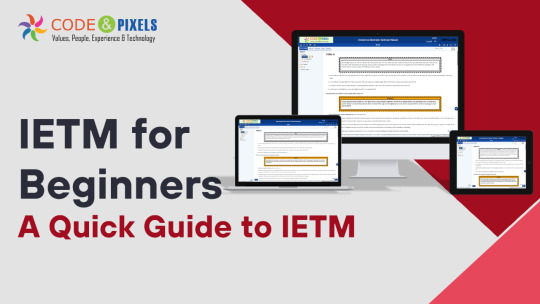
IETM: Interactive Electronic Technical Manual
Training Aids to Defence Client
If you are a supplier of defence then along with the system/equipment you also need to provide Training Aids
(CBT) — Computer-Based Training
Charts and Bloups
Video Film
Training Work Modules
Manuals Hard Copies
IETM
Evolution of Documentation in Defence
Before — Hardcopies and PDFs in DVDs (Upto 2015)
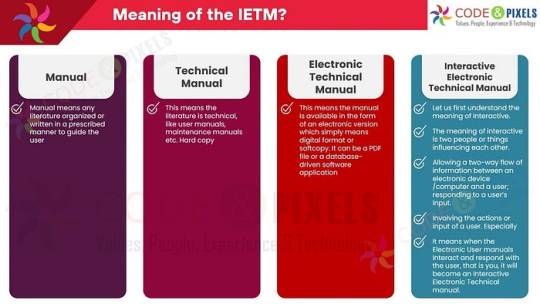
What is the meaning of the IETM?
Manual: Manual means any literature organized or written in a prescribed manner to guide the user.
TechnicalManual: This means the literature is technical, like user manuals, maintenance manuals etc. Hard copy
Electronic Technical Manual: This means the manual is available in the form of an electronic version which simply means digital format or softcopy. It can be a PDF file or a database-driven software application.
Interactive Electronic Technical Manual:
Let us first understand the meaning of Interactive. The meaning of interactive is two people or things influencing each other.
Allowing a two-way flow of information between an electronic device /computer and a user; responding to a user’s input.
Involving the actions or input of a user. Especially
It means when the Electronic User manuals Interact and respond with the user, that is you, it will become an Interactive Electronic Technical manual.
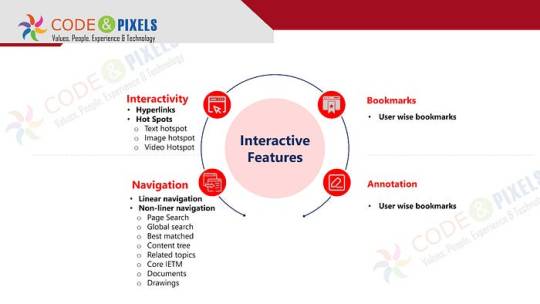
Interactive Features
Interactivity
Hyperlinks
Hot Spots
Text hotspot
Image hotspot
VideHotspot
Bookmarks
User wise bookmarks
Navigation
Linear navigation
Non-liner navigation
Page Search
Global search
Best matched
Content tree
Related topics
Core IETM
Documents
Drawings
Annotation
User wise bookmarks
The documents and pages are many hence, for easy and fast accessibility complete content is converted and stored as a database.
Whenever the user wants some information, IETM software produces the information in a fraction of a second.
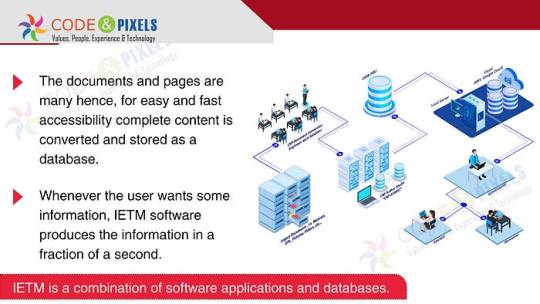
Use or Purpose of the IETM?
The purpose of the Manual is to give information related to the equipment to the end user for quick reference.
All the technicality is written in detail so that when an issue arises, the user can refer to the manual, as every time OEM or technical person or subject matter expert might not be available on the spot to resolve the issue.
If the manual has 10 pages users can refer easily.
But any system used by the defence will have multiple manuals and thousands of page counts and many times a user has to cross-refer between manuals, intra-manual and inter-manual to resolve the issue.
Referring to 10- 15 hard-copy or even soft-copy books simultaneously will be difficult and time-consuming.

How to access the IETM ?
IETM is a web-based application like our bank software or any other web application. The graphic user interface will be provided to use IETM through which users can interact and get the desired data.
Like all other standard software, Unauthorized users cannot access the IETM. IETM is a Login - login-based application. Only users having valid Login credentials can access the software.
Based on the user log credentials data will be provided to the user.
IETM has 2 types of Users and one Administrator
Maintainer
Operator
If the operator logs in, the user gets all the content related to operator use, similarly if the maintainer logs in only maintenance-related content is visible for that user.
Ideally, all the content is available for both users, because the purpose of the IETM is to refer to the manual to fix the issue.
Administrators can create users who can see the user’s navigation and log-in history and interact with the users using user dashboards through Annotations.
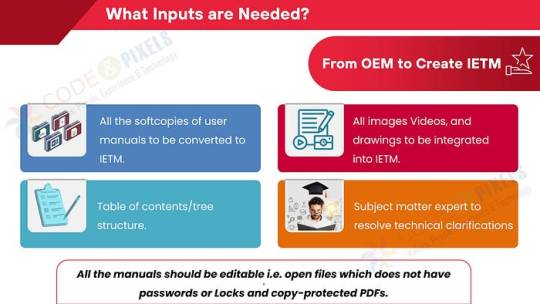
What Inputs are Needed? (From OEM to Create IETM)
All the softcopies of user manuals to be converted to IETM.
All images Videos, and drawings to be integrated into IETM.
Subject matter expert to resolve technical clarifications
Table of contents/tree structure.
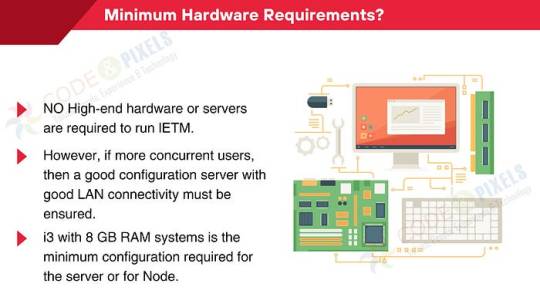
Minimum Hardware Requirements?
NO High-end hardware or servers are required to run IETM.
However, if more concurrent users, then a good configuration server with good LAN connectivity must be ensured.
i3 with 8 GB RAM systems is the minimum configuration required for the server or for Node.
Deliverables
BASED DB (Manuals are covered in the Database)
IETM VIEWER Software
User Manual and Installation Manual
Standards — compliance
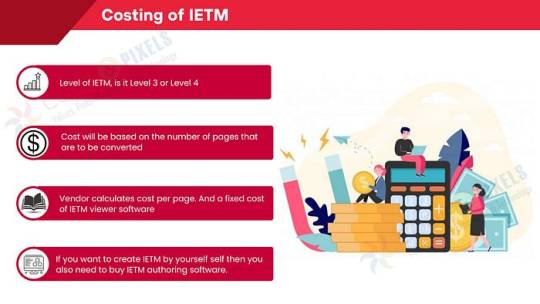
Costing of IETM: (Interactive Electronic Technical Manual)
Level of IETM, is it Level 3 or Level 4
Cost will be based on the number of pages that are to be converted
The vendor calculates the cost per page. And a fixed cost of IETM viewer software
If you want to create IETM by yourself self then you also need to buy IETM authoring software.
What are these Levels?
Level — 1 is any PDF file
Level — 2 is a PDF file with hyperlinks from the table of contents to the body etc.
Level — 3 is an HTML application. More hyperlinks, simple search, a content tree having log a screen with a hardcoded username and password and supplied in the format of EXE so that Windows can easily open
Level — 4 is Software plus Content/manuals converted as Database
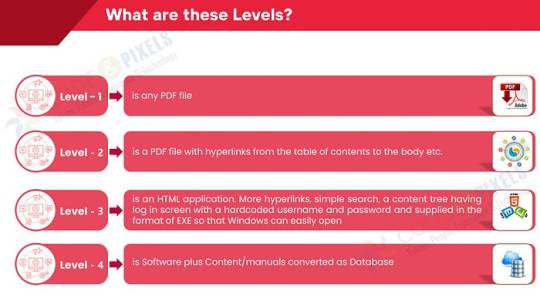
Regarding Level — 5, rest assured, till 2028 it will be Level — 4 only. As of now, there is nothing practically called Level — 5. Few are calling virtual reality and Augmented reality and Artificial intelligence Level — 5.
Pulling data from many user inputs and analyzing and giving results are done in Level — 5. IETM software cannot pull the data from various real-time points as No OEM will give the real-time information to third-party software directly. Yes, if the information is available offline, then that information can be imported into IETM and can be used as a reference.

#ietm#software#technology#ietm developement#ietm code and pixels ietm hyderabad#ietm software#elearning#code and pixels#ietm level iv#codeandpixels#ietm level 4 software requirements#technical documentation#ietm document#ietm documentation#interactive electronic technical manual#Ietm Service Providers#Ietm Software Designers of India#Software Development Company#Elearning Solutions Company#E Learning Content Development Company#Online Education#Digital Education#Digital Content#Software Development Solutions#Elearning#Ietm Developers#Econtent Development#Elearning Solutions Providers#Econtent Developers#Econtent
3 notes
·
View notes
Text
How to Overcome Plateaus in Chess Improvement: 10 Proven Strategies to Keep Climbing

Stuck at the same Elo for weeks—or months? Don’t worry; every chess player, from beginners to grandmasters, hits a plateau sooner or later. A plateau simply means your current study routine has given all it can. The moment you make targeted adjustments, progress restarts. Here are ten coach‑approved techniques from Maestro Chess Academy to break through any chess plateau and accelerate your rating gains.
1. Diagnose the Plateau
First, figure out what’s stalling you. Review your last 20 rated games and tag each mistake: tactical blunder, strategic misunderstanding, time‑management error, or endgame mishandling. Patterns reveal the root cause, so you can focus on the right fix instead of training everything at once.
2. Refresh Your Tactics Routine
Random puzzles feel good but often recycle positions you already know. Switch to pattern‑themed sets—deflection, zwischenzug, clearance sacrifice—and use spaced‑repetition software so critical motifs resurface just before you forget them. Twenty focused minutes a day beats an hour of scatter‑shot solving.
3. Study Classic Games Actively
Choose annotated masterpieces by players one rating class above you. Pause before each critical move and write down your candidate moves, then compare with the grandmaster’s choice. This builds positional intuition and decision‑making far faster than passive replay.
4. Change Your Time Controls
If you grind blitz all day, your calculation muscles atrophy. Replace some 3‑minute sessions with 10 + 5 rapid or weekly 30‑minute classical games. Slower games force you to verbalize plans, spot long tactics, and practice disciplined time allocation.
5. Perform a Post‑Game Triple Check
This layered approach embeds lessons deeply and prevents superficial “click‑next‑move” reviews.
6. Drill Fundamental Endgames
Many plateaus stem from leaking half‑points in simple endings. Master king‑and‑pawn basics, the Lucena and Philidor rook positions, and common bishop‑vs‑knight conversions. Use tablebase trainers until your technique is automatic.
7. Spar in Themed Positions
Start scrimmages from set‑ups like an isolated queen’s pawn middlegame or a rook‑and‑pawn endgame. With the opening theory removed, you’ll focus on plans, not memorized moves, and tackle the exact structures holding you back.
8. Periodize Your Study Plan
Rotate training themes over a four‑week cycle to prevent burnout and ensure balanced growth: Week 1 – intensive tactics and rapid games Week 2 – strategic concept deep dive (e.g., minority attack) Week 3 – endgame drills plus classical analysis Week 4 – over‑the‑board or online tournament for practical testing
9. Track SMART Metrics
Set goals like “Raise my rapid rating from 1400 to 1500 in six weeks” and log weekly snapshots. Specific, measurable targets create accountability and show whether your new routine works.
10. Get Expert Feedback Early
A certified coach spots plateau causes faster than any engine. Personalized guidance, structured training plans, and regular game reviews accelerate progress dramatically. Maestro Chess Academy offers one‑on‑one and group classes—book a free assessment today and jump‑start your improvement.
Conclusion
Chess plateaus aren’t dead ends—they’re signposts telling you it’s time to upgrade your methods. Diagnose the problem, apply the ten strategies above, and watch your rating climb again. Your next breakthrough is just a smart training tweak away. Good luck, and see you on the leaderboards!
0 notes
Text
AutoCAD Online Course in Hyderabad – Learn at Gritty Tech
Discover the Power of AutoCAD from Anywhere in Hyderabad
In today’s fast-paced design and engineering industries, mastering AutoCAD is no longer optional—it's essential. Whether you’re an aspiring architect, civil engineer, mechanical designer, or interior decorator, AutoCAD provides the foundation for all your design and drafting needs. Gritty Tech, a leading technical training institute in Hyderabad, offers a comprehensive AutoCAD online course that enables you to learn from the comfort of your home while enjoying the support and structure of a professional classroom For More …
Why Choose AutoCAD?
AutoCAD, developed by Autodesk, is the most widely used computer-aided design (CAD) software globally. It is used for creating precise 2D and 3D drawings and models across various industries. Professionals use it to draft construction blueprints, architectural layouts, mechanical schematics, and electrical circuits.
Benefits of Learning AutoCAD:
Create professional-grade blueprints and drawings.
Boost productivity with accurate and reusable components.
Gain access to industry-standard design tools.
Open doors to career opportunities in architecture, engineering, and product design.
Why Learn AutoCAD Online in Hyderabad?
Hyderabad is a booming hub for technology, construction, and industrial design. Many top-tier firms in the city seek skilled AutoCAD professionals for roles in design and planning. By enrolling in an AutoCAD online course in Hyderabad, you can upskill without the need to commute or attend physical classes, making it ideal for working professionals and students alike.
AutoCAD Online Course at Gritty Tech – Course Overview
Gritty Tech has designed its AutoCAD online course to cater to beginners and intermediate learners. This course not only teaches you how to use AutoCAD but also equips you with real-world applications to enhance your job readiness.
Key Features:
Live instructor-led classes
Hands-on assignments and projects
Lifetime access to course materials
Industry-recognized certification
1-on-1 mentorship and career guidance
What You’ll Learn in This Course
Module 1: Introduction to AutoCAD
Overview of CAD and its applications
Navigating the AutoCAD interface
Setting up drawing templates
Understanding units, layers, and line types
Module 2: 2D Drafting Techniques
Drawing lines, arcs, circles, and polygons
Object snap and tracking
Modify tools: Move, Copy, Rotate, Mirror
Creating and managing layers
Dimensioning and annotations
Working with blocks and attributes
Module 3: Advanced 2D Tools
External references and underlays
Hatching and gradients
Working with tables
Layouts, viewports, and plotting
Managing drawing standards
Module 4: Introduction to 3D Modeling
Creating 3D primitives: box, sphere, cylinder
Extrude, revolve, loft, and sweep
Solid editing tools
3D views, orbit, and visualization
Rendering and lighting basics
Module 5: Real-Time Project Work
Architectural project (floor plan, elevations)
Mechanical project (machine part design)
Electrical layout drafting
Portfolio creation and review
Tools and Resources Provided
Access to licensed AutoCAD software (student version)
E-books and step-by-step manuals
Pre-recorded backup sessions
Discussion forums and weekly Q&A
Who Should Enroll in the AutoCAD Course?
This course is designed for:
Students pursuing engineering, architecture, or interior design
Working professionals looking to upskill
Draftsmen and technicians
Entrepreneurs in the construction and manufacturing industries
Course Duration and Timings
The AutoCAD online course at Gritty Tech typically spans 6 to 8 weeks, depending on the batch. Flexible weekday and weekend batches are available to suit different schedules.
Available Timings:
Morning Batch: 7:00 AM – 9:00 AM
Evening Batch: 6:00 PM – 8:00 PM
Weekend Batch: Saturday & Sunday – 10:00 AM to 1:00 PM
Career Opportunities After Completing the AutoCAD Course
After gaining AutoCAD skills, learners can explore a range of job roles, including:
CAD Designer
Draftsman
Civil Engineer (Design)
Architectural Assistant
Interior Design Assistant
Mechanical Draftsman
Electrical CAD Technician
These roles are in high demand across sectors like:
Architecture & Construction
Engineering Firms
Interior Design Studios
Product Manufacturing Companies
Government Infrastructure Projects
Why Gritty Tech is the Best Choice in Hyderabad
Experienced Trainers
The trainers at Gritty Tech are certified professionals with hands-on industry experience. They bring real-world challenges into the classroom, making learning practical and relevant.
Real-Time Projects
Each student works on real-time projects to build a practical portfolio. These projects are reviewed by trainers and serve as a valuable addition to your resume.
Personal Mentorship
Students receive individual attention and career guidance throughout the course. One-on-one mentorship ensures that your doubts are addressed, and your career goals are aligned.
Affordable Fee Structure
Gritty Tech offers competitive pricing with easy installment plans. They believe in democratizing quality education for everyone.
Student Testimonials
Thousands of students across Hyderabad have benefitted from Gritty Tech’s online AutoCAD courses. The institute is rated highly for its student satisfaction and success rate.
Frequently Asked Questions (FAQ)
Is AutoCAD difficult to learn for beginners?
Not at all. With structured guidance from Gritty Tech, even beginners can start designing professional drafts within a few weeks.
Can I learn AutoCAD online without prior experience?
Yes. The course is designed for learners at all levels. No prior CAD experience is needed.
What if I miss a class?
All sessions are recorded, so you can watch them later at your convenience. You can also clarify doubts in live Q&A sessions.
How to Enroll in the AutoCAD Course at Gritty Tech
Enrolling is simple. Just visit the official website, navigate to the “Courses” section, and select AutoCAD Online Course. Fill in your details and choose your preferred batch timing. Their support team will guide you through the next steps.
0 notes
Text
Navigating the Tax Landscape: Your Guide to GST Notification Updates and Online Tax Resources
In today's fast-evolving tax environment, staying updated with the latest regulations and resources is essential for businesses and tax professionals alike. The introduction of Goods and Services Tax (GST) in India has transformed the tax landscape, making it more straightforward yet complex with its constant updates and amendments. In this article, we will explore the various avenues available for accessing GST notification updates in India, the benefits of a Tax Book Library Online, and the convenience of using a Tax Book Online and GST E-Library.
Understanding GST Notification Updates in India
The Indian government has implemented a systematic framework for the dissemination of GST notification updates in india. These updates are critical for ensuring compliance and understanding changes in tax obligations. Businesses must stay abreast of these notifications to avoid penalties and make informed decisions.
The GST regime, established on July 1, 2017, aims to streamline indirect taxation by integrating various state and central taxes into a single framework. However, this also means that tax professionals and businesses must navigate through a myriad of notification updates issued by the Central Board of Indirect Taxes and Customs (CBIC) and state authorities. These notifications can range from changes in tax rates, exemptions, procedural rules, to amendments in existing laws.
To keep up with these changes, subscribing to official sources and platforms that provide timely updates on GST notifications becomes imperative. Many online services offer features that allow you to receive alerts directly in your inbox, ensuring you never miss an important update.
The Accessibility of a Tax Book Library Online
As the complexities of tax laws increase, having access to comprehensive resources becomes paramount. A Tax Book Library Online provides an invaluable repository of knowledge for tax professionals, students, and businesses looking to deepen their understanding of taxation.
Imagine having access to numerous tax-related books, manuals, and guides all at your fingertips, anywhere and anytime. An online library takes convenience to a new level. You can search for specific topics or keywords to find the relevant materials swiftly, which can save hours that would otherwise be spent in a physical library.
Moreover, an online tax book library may house a variety of publications, ranging from beginner-level texts to advanced reference materials. This allows users from all backgrounds to find content suited to their educational and professional needs.
Additionally, these libraries often host the latest editions of essential texts that might not be available in print yet, ensuring that you have the most current information at your disposal.
Embracing the Convenience of a Tax Book Online
The world has become increasingly digital, and the tax domain is no exception. A Tax Book Online can revolutionize how tax professionals and students access information. Instead of sifting through stacks of books, users can simply browse through an online interface, making the process much easier and more efficient.
When using a Tax Book Online, you can benefit from features such as bookmarking, highlighting, and annotation, which allow for a more interactive reading experience. These features enable users to keep track of important sections and insights, making revision and preparation for examinations more effective.
Furthermore, many online platforms allow you to purchase or rent books for set periods, making it financially feasible for students or professionals who may not want to invest in physical copies of every book they need.
In the realm of tax compliance and strategy, the ability to quickly access and cross-reference materials can be crucial. Whether you are preparing for an audit or looking to optimize your business's tax strategy, the flexibility that a Tax Book Online offers is unmatched.
Delving into the World of a GST E-Library
The technological advancements of the 21st century have led to the emergence of specialized platforms dedicated to tax education and compliance. A GST E-Library is one such resource that focuses solely on the Goods and Services Tax framework, offering relevant literature, case studies, and practical guides tailored specifically to GST.
This digital library stands out as it organizes materials in a user-friendly manner, often categorizing them by topics such as compliance, returns filing, GST rates, and useful FAQs. One of the primary advantages of a GST E-Library is that it is continuously updated to include the latest changes in legislation and policies.
Imagine having access to a database that not only contains educational articles and publications but also practical templates, checklists, and tools that aid in compliance. The availability of FAQs and case studies helps clarify complex issues, offering real-world applications of the concepts discussed.
Furthermore, a GST E-Library often allows for collaboration. Users can engage in forums or discussion groups to seek advice and share experiences. This creates a community-driven environment, making it easier for those new to the GST system to learn from more experienced peers.
Conclusion
In summary, keeping up with GST notification updates in India and leveraging online tax resources can significantly enhance your understanding and compliance with the tax system. Whether you choose to access a Tax Book Library Online, utilize a Tax Book Online, or explore a GST E-Library, these resources are designed to empower you in your tax education and professional practice.
0 notes
Text
Book review - Quick and Simple Painting in ProCreate
Quick and Simple Painting in Procreate is a great source of learning for both beginner and experienced artists. A quarter of the book is dedicated to a wealth of beginner-friendly introductions to the functions and tools available in Procreate. It explains how to perform basic tasks such as creating canvases, organizing files in the gallery, using tap gestures to undo and rotate, as well as making perfect lines and circles. Additionally, it covers how to use perspective guides—something I only discovered myself after a year or two of using Procreate—making this a particularly helpful piece of information for beginners. The book also explains the use of filters and image adjustments, including curves, saturation, channels, and liquify. The introduction further provides guidance on creating and editing custom brushes, as well as pinning and sorting them for future use.


Another section focuses on blending modes. Even though I am not as much of a beginner as some who may purchase this book, I still would have found such a resource extremely useful because, even now, I do not fully understand how each blending mode works in detail. The book includes an example showcasing each blending mode, which is consistent with the rest of the sections: they all feature detailed images for those who are more visually inclined, allowing them to progress in a step-by-step manner with labels and annotations.
All this knowledge is then put to use in the following section: the tutorials. This part features eight separate tutorials from different artists, guiding the reader through creating artworks similar to theirs with detailed instructions, step-by-step guidance, annotations, and images. Each artist has their own unique style, using different brushes and providing links to download them, ensuring that readers can best emulate their techniques. Every one of these tutorials showcases how to work with textures to enhance the speed and effect of the artwork.

The first tutorial explains how to create custom brushes and customize the default brush shape, paint a stylized cityscape, simplify complex details, and create depth and atmosphere with values. The second tutorial covers painting with default brushes and the selection tool, dividing a scene into organized and minimal layers, applying stylization to an image, and creating landscapes with reflections on surfaces like water. The third tutorial explores painting in a sketchy, textured style, building up a painting with minimal layers, using selections to create gradients and details, and utilizing adjustment options to refine colors and textures. The fourth tutorial teaches how to adapt an image from a photo reference, create stylized flowers and foliage, use blur effects to create depth of field, and add focus and appeal with a character. The fifth tutorial discusses painting an atmospheric sunset environment, using real-life inspiration to create a magical scene, using the smudge tool, and adding depth through mist, scale, and lighting. The sixth tutorial explains how to create strong line and color thumbnails, set a mood and time of day through color choices, use textured custom brushes for a stylized effect, and paint stylized water inspired by real life. The seventh tutorial provides insights on illustrating a stylized fantasy scene, creating depth in a landscape, using selections to create objects, and painting with a sketchy, fluid approach. Finally, the eighth tutorial teaches how to paint a cozy urban nighttime scene, use block colors to organize objects in a scene, create manual masks for painting and shading, and build up light effects using layer blend modes.

My favorite tutorials from this section are the third one, Furry Friends by Jackie Droujko, the sixth one, On the Beach by Alone Lee, and the final one, Les Bonbons d’Owen by Owen Labbe.
The Furry Friends tutorial was one of the main reasons I purchased this book. I was already familiar with the artist and had been watching Jackie’s videos on YouTube. Her sketchy style appeals to me, and it is something I want to emulate in my own work. Even though sketchiness can sometimes create muddiness, she manages to produce a clear and compelling illustration. The use of texture is a central aspect of her tutorial. Many of the steps in her process involve either using textured brushes or creating texture through various means, such as keeping the initial sketch visible and transparent or adding noise and chromatic aberration later in the process. Jackie also strongly emphasizes the importance of avoiding tunnel vision or hyper-focusing on one section. She urges the reader to spread their attention across different parts of the artwork to maintain motivation and prevent getting stuck. One particularly helpful technique I learned from her tutorial was the use of Gradient Maps to create more interesting color variations. Overall, this tutorial was highly informative, and the artist’s work is both appealing and engaging.


Alone Lee’s tutorial, On The Beach, was the most useful one for me personally due to her stylization and workflow. She encourages the reader to sketch out all their ideas first and then refine them into a composition. She also advises taking one’s own reference photos, as this makes the final illustration more personal and helps the artist better understand what they are drawing. Her explanation of composition is insightful, and the accompanying visual aids make it even more effective. Her working method is something I aim to improve upon, as I already work in a similar way but hope to refine it further. Her use of simple shapes and design is distinctive and plays a key role in her artistic language, which I find to be an interesting approach to illustration. She also utilizes custom brushes to achieve her unique stylization. Additionally, she uses blur in an intriguing way to create reflections and guide focus within the piece. Her entire process is appealing because she demonstrates how to create an interesting, stylized piece in a relatively short amount of time without investing excessive hours into rendering. Her simple use of colors and shapes contributes to this time-efficient aspect of her work. I find that Alone Lee’s illustrations share a visual aesthetic with photography, as they depict people in various everyday scenarios while applying similar compositional principles.


Owen Labbe’s tutorial, Les Bonbons d’Owen, is on a more advanced level compared to the previous tutorials, which makes sense as it is placed at the end of the book. His work has a distinct animator-like quality, with rounded, lively characters and a whimsical feel. A significant portion of this tutorial focuses on color theory, helping the reader understand how to use colors effectively in a scene with numerous different elements. He provides insightful tips on creating texture and implying detail in objects, such as adding wood grain to wooden sections or defining the stone tiles on a rooftop. In addition to color, the tutorial also emphasizes lighting techniques, as the scene is set at nighttime with illuminated shop lights. Owen explains how to create value studies, allowing the reader to grasp how to apply such techniques in their own work. To enhance vibrancy and bring life to a scene, he includes numerous details and encourages the reader to apply their own artistic flair using similar methods. Another key aspect of the tutorial is teaching how to separate a composition into masks to make shading and shadow placement more efficient. His method follows the background-midground-foreground rule, which is something I hope to incorporate into my own workflow. I have been trying to transition into painting without linework, and Owen’s approach aligns with my artistic goals. His insights have inspired me to work towards achieving this technique, and I plan to apply what I have learned in the coming months.

Overall, this book is highly informative. The tutorials are well-paced and offer valuable insight into the workflows of various professionals. For beginners, this book is highly recommended. Some of the terminology may feel daunting at times, though the glossary and index help mitigate this; however, the knowledge gained from this book is incredibly valuable, especially when learned early in one’s artistic journey. I wish this book had been available a few years ago so I could have discovered these techniques earlier in my career, but even now, I find much of the information relevant and beneficial to my workflow. Following each tutorial step-by-step will gradually improve one’s skills. Even just selecting the tutorials that feel most relevant to your own style will still be useful. Completing all the tutorials at a steady pace will likely take a few months if practiced consistently, but doing them intermittently in your free time could take up to a year.
In conclusion, I am very happy with my purchase of this book and would highly recommend it to both beginners and experienced illustrators alike.
0 notes
Text
Want to learn AngularJS? We have compiled angular tutorials that cover all aspects of AngularJS programming including angular js basics, angular js examples and more. Angular JS bridges the gap and allows you to develop applications and dynamic web pages using both HTML and Java Script. It's a framework that makes it easy for developers to design client side applications. Use metadata to annotate on your DOM, and the angular will work on the DOM and manipulate it for you. Angular JS is the solution to accelerate your programming and coding skills and get down to designing serious professional apps that have true market potential. Learning Angular JS becomes easy with the step-by-step angular JS tutorials available online. Knowing about the best online resources saves time and ensures that you have the best possible learning experience, and save time by accelerated learning and quick-paced instruction delivery enhanced by multi-media resources and e-learning tools. You may also like to read best AngularJS books. Beginners Tutorials and Step By Step Guide Online angular JS tutorials start from the fundamental basics, explain key concepts in a simple and easy to understand manner, and then proceed to explain Angular JS in a step-by-step and systematic manner. Completing a tutorial can be a big step toward creating your own first app and quickly bridging the gap between HTML and JavaScript. How to get started All about Angular JS New to AngularJS learning Angular JS for beginners, step-by-step AngularJS Tutorial - Learn AngularJS in 30 minutes A comprehensive angular JS tutorial for newbies AngularJS for Absolute Beginners : Medialoot Basic Angular JS: Explained Comprehensive Beginner's Guide to AngularJS - AntJanus A Complete Guide: Angular JS for the absolute beginner Websites For Learning Angular JS Some great websites are dedicated exclusively for providing Angular JS tutorials that explain every concept clearly. These websites offer links to download Angular JS tutorials, comprehensive Angular JS learning and sequential and systematic explanations. E-learning resources, simplify learning and teach you everything about Angular JS, which is rapidly gaining popularity among developers. AngularJS Tutorial Angulr JS made easy: Comprehensive Angular JS tutorial A Better Way to Learn AngularJS Simplified approach to Angular JS learning AngularJS Fundamentals of Angular JS learning AngularJS Tutorial Easy tutorial for Angular JS study Online Courses on Angular JS An online course that explains the most complex concepts in a way that grasping information will become easy for any beginner. Efficient instruction delivery, continuous discussions, and high quality instructional videos make this course unique and powerful. Complete Angular JS tutorials, rapid Angular JS learning and Angular JS tutorial videos. AngularJS Tutorial - Code School Beginning with Angular JS Best Cheatsheets and Guides for AngularJS Angular JS style guides and cheatsheets are of great help in the beginning, and provide a useful list of references about the most essential and commonly used features. For SPAs or Single Page Applications, Angular JS provides one of the best available frameworks, and cheatsheets will help you in quickly becoming productive and save time. toddmotto/angularjs-styleguide · GitHub Standardized approach to Angular JS johnpapa/angular-styleguide · GitHub Professional styles for Angular JS mgechev/angularjs-style-guide · GitHub Comprehensive Style Guide for Angular JS gocardless/angularjs-style-guide · GitHub Angular JS Style Guide Angular JS Style Guide A Complete Style Guide for Angular JS Core Injectables PDF Core Injectables simplified for Angular JS DDOs PDF DDOs for Angular JS Angular JS Cheatsheet The complete cheatsheet for Angular JS Video Tutorials For Angular.js Video tutorials on You Tube are a free resource for learning almost everything about Angular JS. Some
of the top developers currently working on their own projects provide practical and simple instructions on learning Angular JS, core fundamental concepts, Angular 2.0, and other topics and concepts. Angular JS Tutorials And Resources - YouTube Complete Collection of Angular JS videos and Tutorials Realtime Eye Candy with AngularJS Angular JS Tutorial creating real time applications AngularJS & D3: Directives for Visualizations - YouTube Angular JS directives and visualizations AngularJS Fundamentals In 60-ish Minutes - YouTube Crash course in the fundamentals of Angular JS Introduction & Explore to AngularJS at 2015 - YouTube Angular JS fully explained Learn and Understand AngularJS - The First 50 Minutes - YouTube Basics of Angular JS Introduction to Angular JS - YouTube Maling a simple application with Angular JS " AngularJS + REST Made Simple: Connecting AngularJS to a Backend with REST & JSON - YouTube Angular JS made really simple " Egghead.io - AngularJS - Binding - YouTube Understanding Binding in Angular JS Realtime Eye Candy with AngularJS Angular JS Tutorial creating real time applications Angular 2.0 Core by Igor Minar & Tobias Bosch at ng-europe 2014 - YouTube Core Basics of Angular JS with Tobias & Igor Building games with AngularJS by Ari Lerner at ng-europe 2014 - YouTube Creating interactive web-based games with Angular JS Famo.us Angular by Zack Brown at ng-europe 2014 - YouTube Learning Angular JS with Zack Brown TypeScript and Angular 20 Jonathan Turner - YouTube Using typescript and Angular 2.0 Features of Angular JS Features of Angular JS Misko Hevery and Rado Kirov on Angular- YouTube Angular 2.0 - keynote at the ng-conf 2015 What's coming in Angular 2.0 - YouTube Exploring and understanding Angular 2.0 angular JS tutorial - YouTube Complete Angular JS tutorial videos collection AngularJS with ASP.NET MVC4 - YouTube ASP.NET MVC4 with Angular JS Java EE and Angular - YouTube Angular JS tutorial end-to-end Web Development Using Spring and AngularJS - YouTube Angular JS and Spring for Web Development Blogs and News About Angular.js Angular 2.0 means a better framework than Angular JS and has many great features, but at the same time developers used to the old Angular JS will have to spend a significant amount of time adapting to changes and getting used to the new framework. Online Angular 2.0 tutorials have all the necessary information for a smooth transition to the new framework, and utilizing online resources can make you proficient in a short span of time. AngularJS (@angularjs) | Twitter Twitter for Angular JS AngularJS - YouTube Basics of Angular 2.0 AngularJS — Superheroic JavaScript MVW Framework Knowing all about Angular JS All About Angular 2.0 Understanding Angular JS Angular2 Simple basics of Angular 2.0 Angular 2.0 Changes - CodeProject Changes is Angular JS Migrating to AngularJS 2.0 Transitioning to Angular 2.0 Preparing for the future of AngularJS Angular 2.0: A new vision AngularJS 2.0: Sneak Preview on Data Binding Data Binding in Angular 2.0 Two Phases of Angular 2 Applications Bi-phasic nature of Angular 2.0 apps Angular 2 Forms Forms in Angular 2.0 Angular 2: Template Syntax Template Syntax for Angular 2.0 Change Detection in Angular 2 Detecting change in Angular 2.0 Angular 2 Series: Introduction An introduction to Angular 2.0 Better Support for Functional Programming Functional programming with Angular 2.0 Useful Tutorials and Articles on AngularJS The Angular JS framework provides tools that can make a huge difference to any developer's productivity, and tutorials and presentations try to describe every important aspect with practical examples. All tutorials begin with simple basics and fundamentals and move on to the advanced practical application of concepts. Hard to learn, important concepts have been covered by various experts in separate presentations and articles. A lot of developers who are preparing to transition from Angular JS to Angular 2.
0 will find these resources extremely useful. AngularJS Tutorial: a comprehensive 10,000 word guide A complete Angular JS tutorial Tutorials - Binpress Development with Angular JS tutorials All About the Built-In AngularJS Filters Learning Angular JS filters Advanced AngularJS In-depth look into Angular JS A Different Angle: What is AngularJS Knowing simple basics of Angular JS Difference between Service, Factory and Provider in AngularJS Angular basics: Factory, service, and provider AngularJS Performance in Large Applications Resolving performance issues in big applications: Angular JS Why AngularJS makes every single developer a better one Using Angular JS to become a better developer Speeding up AngularJS apps with simple optimizations - Tutorial - Binpress Optimization of Angular JS Apps A Practical Guide to AngularJS Directives - SitePoint A practical understanding of Angular JS directives AngularJS Directive Best Practices Utilizing Angular JS directives Simple applications with Angular 2.0 Simple applications with Angular 2.0 Creating a CRUD App in Minutes with Angular's $resource Using the $ resource in Angular: CRUD app development Using RESTful Controllers In An AngularJS Resource Using the RESTful resource: Learning Angular JS Learn to Build Modern Web Apps with MEAN The Mean stack: MongoDB and Angular JS Your First AngularJS App: A Comprehensive Tutorial Making an app with Angular JS Learn AngularJS With These 5 Practical Examples Practical examples to learn Angular JS AngularJS for Absolute Beginners : Medialoot Beginning with Angular JS AngularJS Tutorial - Auth0 Docs Angular JS a simple tutorial AngularJS Routing Using UI-Router Routing with Angular JS Learn Angular by Building a Gmail Clone Getting started with Angular Learn AngularJS Online - A Guide Learning Angular JS: Online Angular JS learning Backendless development with AngularJs Developing with Angular without backend api A Better Way to Learn AngularJS Better approach to learning Angular JS A Curated List Of Angular-Js Directives Angular directives reference list AngularJS Cheat Sheet by ProLoser A comprehensive list of all Angular cheat codes CRUD Operations using ASP.NET Web API and Angular.js Performing CRUD operations with Angular JS Integrating Web Components with AngularJS · Pascal Precht Understanding web component integration with Angular JS Learn to Build Modern Web Apps with MEAN The Mean stack: MongoDB and Angular JS AngularJS Custom Directives Implement your own custom directives with Angular JS AngularUI for AngularJS All about the UI: Angular JS Simple extensions for common Cordova Plugins Cordova extensions for Angular JS jmcunningham/AngularJS-Learning · GitHub Angular JS basics: A complete tutorial Best Free PDF Tutorials and eBooks On Angular JS Angular JS learning tutorials in PDF and e-book format provide a great resource for knowing all about angular JS. The systematic approach to understanding Angular JS starts from core basics and first mastering them effectively, then gradually integrating that knowledge with readily available practical examples. Knowing the differences between Angular JS and Angular 2.0, and preparing for a transition to the new framework. Angular JS download PDF tutorial Angular JS download PDF tutorial Basics of angular in 60 minutes Basics of angular in 60 minutes Learn AngularJS Step by Step A systematic approach to learning Angular JS Download PDF Versions of AngularJS Tutorial Download a complete tutorial for Angular JS Build You own Angular JS Building your Angular Learning Angular Learning Angular with examples Stanford University PDF On Angular Knowing Angular JS PDF JS Tutorials With Examples Java Script for the absolute beginner Getting Started With Angular JS Learning Angular JS basics with examples Dan Wahlin - AngularJS in 60-ish Minutes – The eBook An e-book for a quick review of Angular JS
Recipes with Angular.js - Consuming RESTful APIs Angular JS recipes Angular Basics by ScriptyBooks - Introduction e-book for learning Angular Basics AngularJS Basics with Example Learning Angular JS with practical examples Forums and Message Boards To Discuss Angular JS Angular JS has evolved into the most popular framework for app developers and knowing all about is absolutely essential for new developers. Learning from online resources accelerates learning, but most tutorials often miss key issues that come up when actually get down to developing your first app. Forums provide simpler answers, great links, and can often be a great resource for learning absolutely new things. Google Groups Angular JS: Forum discussion on common problems Angular JS On Reddit Discussions, job links and articles for Angular JS Codecademy AngularJs Forum Core basics of Angular JS Newest 'angularjs' Questions - Stack Overflow Questions and answers for Angular JS Summary A multitude of online resources makes it necessary for any beginner to analyze the quality of resources, and choose from among the best sources of information. Online videos created by developers who are currently employed and have vast experience in the field can be the best resources for learning about Angular JS and Angular 2.0. Mastering the basics and core fundamentals is, however, the most essential part of learning and online tutorials provide every reference resource you need. The newest concern among developers of transitioning from Angular JS to Angular 2.0 has also been comprehensively explained.
0 notes